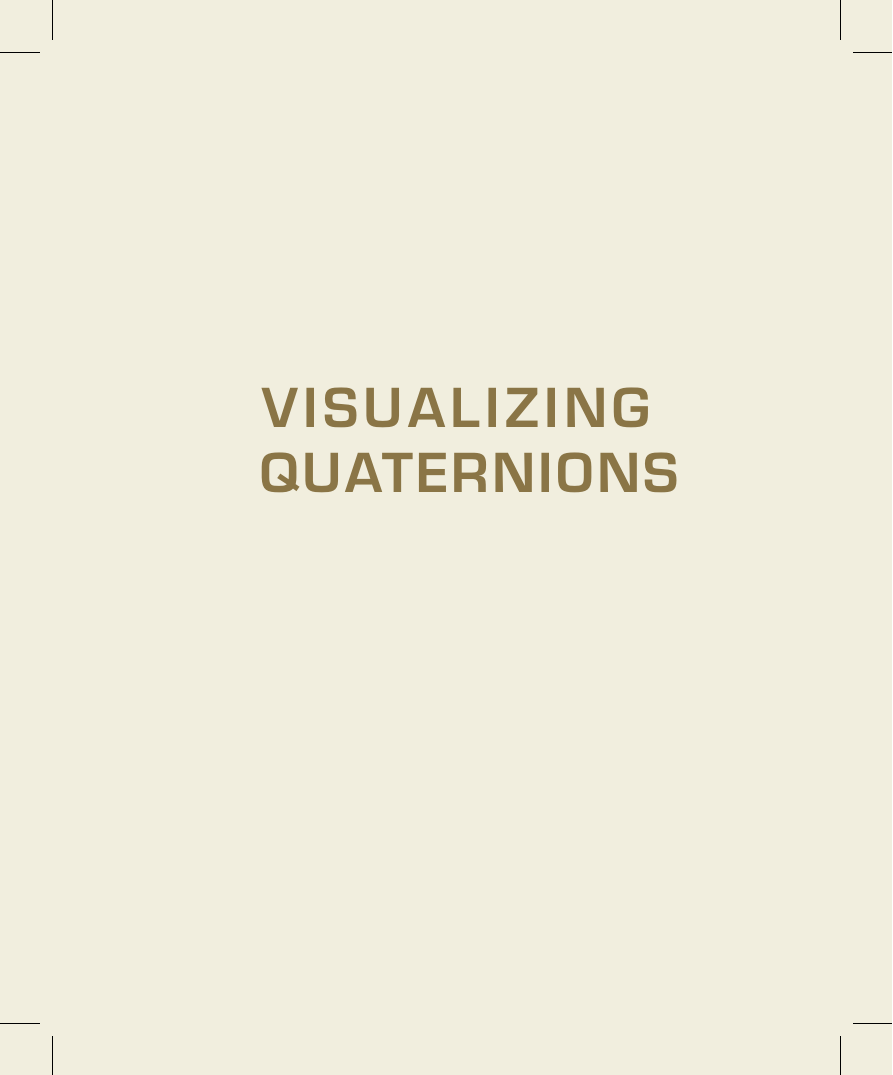Contents
Foreword
Preface
Acknowledgments
Elements of Quaternions
The Discovery of Quaternions
Hamilton's Walk
Then Came Octonions
The Quaternion Revival
Folklore of Rotations
The Belt Trick
The Rolling Ball
The Apollo 10 Gimbal-lock Incident
3D Game Developer's Nightmare
The Urban Legend of the Upside-down F16
Quaternions to the Rescue
Basic Notation
Vectors
Length of a Vector
3D Dot Product
3D Cross Product
Unit Vectors
Spheres
Matrices
Complex Numbers
What Are Quaternions?
Road Map to Quaternion Visualization
The Complex Number Connection
The Cornerstones of Quaternion Visualization
Fundamentals of Rotations
2D Rotations
Quaternions and 3D Rotations
Recovering theta and n
Euler Angles and Quaternions
Optional Remarks
Conclusion
Visualizing Algebraic Structure
Algebra of Complex Numbers
Quaternion Algebra
Visualizing Spheres
2D: Visualizing an Edge-On Circle
The Square Root Method
3D: Visualizing a Balloon
4D: Visualizing Quaternion Geometry on S3
Visualizing Logarithms and Exponentials
Complex Numbers
Quaternions
Visualizing Interpolation Methods
Basics of Interpolation
Quaternion Interpolation
Equivalent 3 x 3 Matrix Method
Looking at Elementary Quaternion Frames
A Single Quaternion Frame
Several Isolated Frames
A Rotating Frame Sequence
Synopsis
Quaternions and the Belt Trick: Connecting to the Identity
Very Interesting, but Why?
The Details
Frame-sequence Visualization Methods
Quaternions and the Rolling Ball: Exploiting Order Dependence
Order Dependence
The Rolling Ball Controller
Rolling Ball Quaternions
Commutators
Three degrees of freedom from two
Quaternions and Gimbal Lock: Limiting the Available Space
Guidance System Suspension
Mathematical Interpolation Singularities
Quaternion Viewpoint
Advanced Quaternion Topics
Alternative Ways of Writing Quaternions
Hamilton's Generalization of Complex Numbers
Pauli Matrices
Other Matrix Forms
Efficiency and Complexity Issues
Extracting a Quaternion
Efficiency of Vector Operations
Advanced Sphere Visualization
Projective Method
Distance-preserving Flattening Methods
More on Logarithms and Exponentials
2D Rotations
3D Rotations
Using Logarithms for Quaternion Calculus
Quaternion Interpolations Versus Log
Two-Dimensional Curves
Orientation Frames for 2D Space Curves
What Is a Map?
Tangent and Normal Maps
Square Root Form
Three-Dimensional Curves
Introduction to 3D Space Curves
General Curve Framings in 3D
Tubing
Classical Frames
Mapping the Curvature and Torsion
Theory of Quaternion Frames
Assigning Smooth Quaternion Frames
Examples: Torus Knot and Helix Quaternion Frames
Comparison of Quaternion Frame Curve Lengths
3D Surfaces
Introduction to 3D Surfaces
Quaternion Weingarten Equations
Quaternion Gauss Map
Example: The Sphere
Examples: Minimal Surface Quaternion Maps
Optimal Quaternion Frames
Background
Motivation
Methodology
The Space of Frames
Choosing Paths in Quaternion Space
Examples
Quaternion Volumes
Three-degree-of-freedom Orientation Domains
Application to the Shoulder Joint
Data Acquisition and the Double-covering Problem
Application Data
Quaternion Maps of Streamlines
Visualization Methods
3D Flow Data Visualizations
Brushing: Clusters and Inverse Clusters
Advanced Visualization Approaches
Quaternion Interpolation
Concepts of Euclidean Linear Interpolation
The Double Quad
Direct Interpolation of 3D Rotations
Quaternion Splines
Quaternion de Casteljau Splines
Equivalent Anchor Points
Angular Velocity Control
Exponential-map Quaternion Interpolation
Global Minimal Acceleration Method
Quaternion Rotator Dynamics
Static Frame
Torque
Quaternion Angular Momentum
Concepts of the Rotation Group
Brief Introduction to Group Representations
Basic Properties of Spherical Harmonics
Spherical Riemannian Geometry
Induced Metric on the Sphere
Induced Metrics of Spheres
Elements of Riemannian Geometry
Riemann Curvature of Spheres
Geodesics and Parallel Transport on the Sphere
Embedded-vector Viewpoint of the Geodesics
Beyond Quaternions
The Relationship of 4D Rotations to Quaternions
What Happened in Three Dimensions
Quaternions and Four Dimensions
Quaternions and the Four Division Algebras
Division Algebras
Relation to Fiber Bundles
Constructing the Hopf Fibrations
Clifford Algebras
Introduction to Clifford Algebras
Foundations
Examples of Clifford Algebras
Higher Dimensions
Pin(N), Spin(N), O(N), SO(N), and all that…
Conclusions
Part Appendices
Notation
Vectors
Length of a Vector
Unit Vectors
Polar Coordinates
Spheres
Matrix Transformations
Features of Square Matrices
Orthogonal Matrices
Vector Products
Complex Variables
2D Complex Frames
3D Quaternion Frames
Unit Norm
Multiplication Rule
Mapping to 3D rotations
Rotation Correspondence
Quaternion Exponential Form
Frame and Surface Evolution
Quaternion Frame Evolution
Quaternion Surface Evolution
Quaternion Survival Kit
Quaternion Methods
Quaternion Logarithms and Exponentials
The Quaternion Square Root Trick
The a->b formula simplified
Gram-Schmidt Spherical Interpolation
Direct Solution for Spherical Interpolation
Converting Linear Algebra to Quaternion Algebra
Useful Tensor Methods and Identities
Quaternion Path Optimization Using Surface Evolver
Quaternion Frame Integration
Hyperspherical Geometry
Definitions
Metric Properties
References
Index
















 2023年江西萍乡中考道德与法治真题及答案.doc
2023年江西萍乡中考道德与法治真题及答案.doc 2012年重庆南川中考生物真题及答案.doc
2012年重庆南川中考生物真题及答案.doc 2013年江西师范大学地理学综合及文艺理论基础考研真题.doc
2013年江西师范大学地理学综合及文艺理论基础考研真题.doc 2020年四川甘孜小升初语文真题及答案I卷.doc
2020年四川甘孜小升初语文真题及答案I卷.doc 2020年注册岩土工程师专业基础考试真题及答案.doc
2020年注册岩土工程师专业基础考试真题及答案.doc 2023-2024学年福建省厦门市九年级上学期数学月考试题及答案.doc
2023-2024学年福建省厦门市九年级上学期数学月考试题及答案.doc 2021-2022学年辽宁省沈阳市大东区九年级上学期语文期末试题及答案.doc
2021-2022学年辽宁省沈阳市大东区九年级上学期语文期末试题及答案.doc 2022-2023学年北京东城区初三第一学期物理期末试卷及答案.doc
2022-2023学年北京东城区初三第一学期物理期末试卷及答案.doc 2018上半年江西教师资格初中地理学科知识与教学能力真题及答案.doc
2018上半年江西教师资格初中地理学科知识与教学能力真题及答案.doc 2012年河北国家公务员申论考试真题及答案-省级.doc
2012年河北国家公务员申论考试真题及答案-省级.doc 2020-2021学年江苏省扬州市江都区邵樊片九年级上学期数学第一次质量检测试题及答案.doc
2020-2021学年江苏省扬州市江都区邵樊片九年级上学期数学第一次质量检测试题及答案.doc 2022下半年黑龙江教师资格证中学综合素质真题及答案.doc
2022下半年黑龙江教师资格证中学综合素质真题及答案.doc